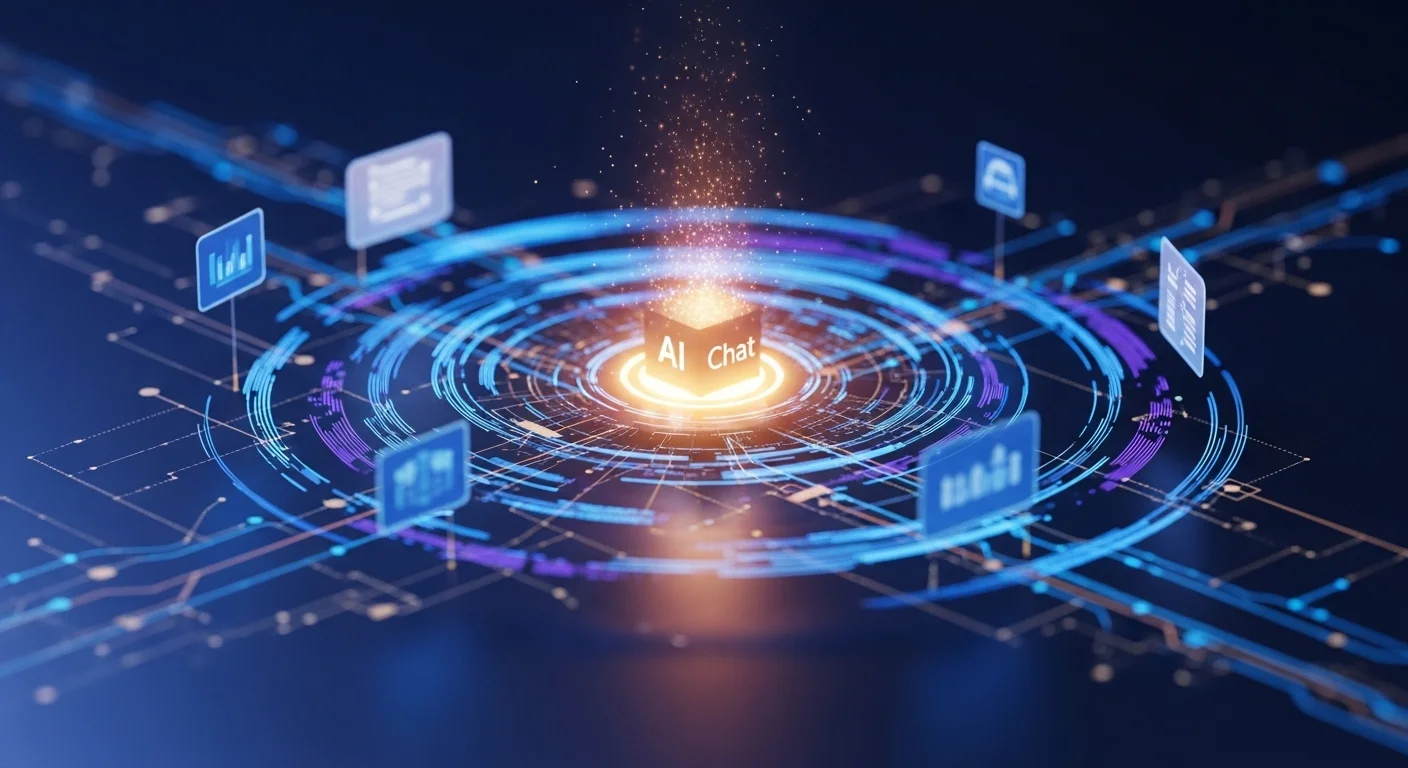Your 2025 Guide to AI Chat: How It's Really Changing Business and Tech

Executive Summary
In my years working in digital strategy, I've seen technologies come and go. But AI Chat is different. It's not just another tool; it's a fundamental shift in how we connect with customers and information. This isn't just about chatbots anymore. We're talking about sophisticated conversational AI, powered by incredible models like those behind GPT, that can understand and respond with stunning accuracy. In this guide, I'll take you through the entire landscape, from its core concepts to advanced business strategies. We'll look at how businesses are using it to transform their marketing and support, and we'll even touch on the fun side, like apps for chatting with AI friends, to understand the full picture. Consider this your personal briefing on where AI Chat is today and where it's headed.
Table of Contents
Table of Contents
What is AI Chat and Why Does It Matter?
It feels like you can't go a day without hearing about 'AI Chat.' It’s gone from a niche tech term to a major headline, and for good reason. At its heart, AI Chat is simply a program that simulates a human conversation. But that simple definition hides a world of complexity. This technology is powered by brilliant fields of AI like Natural Language Processing (NLP), which helps machines understand the nuances of how we talk, and Machine Learning (ML), which allows them to get smarter over time by learning from data. The real breakthrough, however, has been Large Language Models (LLMs)—the engine behind tools like GPT. I've seen firsthand how these models have enabled conversations that aren't just robotic, but genuinely helpful and surprisingly human.
So, why is this such a big deal? For decades, we've had to learn the language of computers, clicking through menus and navigating complex interfaces. AI Chat flips that script. Now, technology is learning our language. This shift is making technology more accessible and incredibly efficient. For businesses, the impact is massive. I’ve worked with companies that went from drowning in customer emails to providing instant, 24/7 support. A well-trained AI can handle thousands of conversations at once, something no human team could ever do. This isn't about replacing people; it's about freeing up your best team members to handle the truly complex problems that need a human touch, like creative solutions and empathetic support.
The Evolution from Simple Bots to Smart AI
The journey to today's AI Chat has been a long one. I remember the early days of rule-based chatbots. Think of programs like ELIZA from the 60s; they were clever for their time, but they just matched keywords to pre-written responses. If you went off-script, they'd break. The leap from those simple bots to today's conversational AI is like comparing a bicycle to a starship. Modern systems don't just look for keywords; they grasp your intent, understand the context of the conversation, and can even pull in information from outside sources. This was all made possible by huge leaps in computing power, access to massive amounts of training data, and the development of the Transformer model, which is the 'T' in GPT (Generative Pre-trained Transformer).
This progress has opened up a world of possibilities. In e-commerce, I've seen AI chats guide shoppers to the perfect product, almost like a personal shopper. In healthcare, they're helping schedule appointments and answer basic medication questions. But it’s not all business. The tech has also branched into entertainment. An app like 'Chai', where you can chat with AI friends, shows a different side of this technology. It focuses on creating engaging, personal connections. This split is fascinating because it shows how versatile AI Chat has become—it's evolving into a technology that can meet both our professional needs and our social desires, weaving itself into the fabric of our digital lives.
How Businesses Benefit from AI Chat
For any forward-thinking business, adopting AI Chat is no longer a question of 'if,' but 'how.' The advantages go way beyond just cutting costs and improve nearly every customer touchpoint.
- Next-Level Customer Service: This is the most obvious win. An AI chat can offer immediate, round-the-clock answers to common questions, track orders, or handle returns. That instant help makes for happier, more loyal customers.
- Generating Leads and Driving Sales: A smart AI can proactively engage visitors on your website, ask qualifying questions to see if they're a good fit, and even book a meeting for your sales team. I've seen this shorten sales cycles dramatically.
- Personalized Marketing: AI chats are great at gathering insights into what customers want. This data is gold for creating marketing campaigns and product recommendations that feel personal and relevant, not generic.
- Streamlining Internal Work: Don't forget your own team! AI can act as an internal helpdesk for HR or IT, answering questions about company policies or troubleshooting tech problems. This makes everyone more productive.
- Invaluable Data and Insights: Every single conversation is a source of raw, unfiltered feedback. By analyzing these chats, businesses get a direct line into customer frustrations, ideas, and market trends, which is crucial for making smart decisions.
The real magic of a system built on a GPT model is its ability to learn. The more it interacts, the better it gets, creating a cycle of constant improvement. The companies I see succeeding are the ones that are embracing this technology now, building a foundation of data and experience that will become a massive competitive advantage down the road. The power to understand and serve customers at scale, with a personal touch, is what defines a modern company, and AI Chat is the key that unlocks it.

A Practical Guide to AI Chat for Your Business
Putting an AI Chat strategy into place is more than just picking some software off a shelf. From my experience, it's about really understanding the tech, having a clear goal, and taking a smart, step-by-step approach to get it right. Here’s how I walk business leaders and tech teams through the process.
Understanding the Tech: Rules vs. Real AI
When you boil it down, AI Chat tools fall into two main camps: the old-school rule-based bots and the new-school AI-powered ones. Knowing the difference is key to choosing the right tool for the job.
- Rule-Based Chatbots: These are the classic chatbots that follow a strict script, like a flowchart. They're great for simple, predictable tasks—like answering five specific FAQs or guiding someone through a form. They're reliable for what they do, but they have zero flexibility. Ask them an unexpected question, and you'll get that dreaded 'Sorry, I don't understand' response.
- AI-Powered Chatbots: This is where the magic happens. These systems use advanced AI—like the NLP and LLMs we talked about—to actually understand what a user is saying. A chatbot powered by a GPT model is a prime example. It doesn't need a rigid script because it can figure out the user's intent and come up with a relevant, natural-sounding answer. This is what allows for a truly helpful and human-like conversation.
Honestly, the best setups I've seen use a hybrid approach. They might use a simple rule-based flow to get basic info (like a name and email) and then let the powerful AI take over for the real conversation. This gives you the best of both worlds: the reliability of rules and the intelligence of AI.
How to Choose and Implement Your AI Chat
Picking the right platform is a big decision. Here are the steps I always recommend:
- Define Your Goal: First things first, what do you need this to do? Is it for customer support? Generating leads? Helping your own employees? Your specific goal will dictate everything else. An AI for scheduling appointments is very different from one for solving complex technical problems.
- Build or Buy?: You can go with an all-in-one platform from a company like Intercom or Drift, or you can build a custom solution using powerful APIs from providers like OpenAI, Google, or Microsoft. The platforms are quicker to get started, but a custom build gives you complete control and flexibility.
- Check for Integrations: This is a big one. Your AI chat can't be an island. It has to connect smoothly with your other tools—your CRM, e-commerce site, and helpdesk software. This is how the AI can pull customer history to personalize a chat or create a new support ticket in the right system.
- Think About Scale and Security: As your business grows, so will your chat volume. Your platform has to be able to handle that growth without slowing down. And since you'll be handling customer data, top-notch security and compliance with rules like GDPR are non-negotiable.
- Look at the Analytics: A good platform will show you exactly how your AI is performing. You need to see metrics like how many issues are being resolved, how satisfied users are, and where conversations are failing. These numbers are your roadmap for making the AI better over time.
My advice is to start small. Launch a pilot project that tackles one specific, high-value problem. Feed the AI with your company's real data—product info, policies, common questions. Test it like crazy, and always have a clear, easy way for the chat to be handed off to a human. This 'human in the loop' approach is the secret to a successful launch.
The Difference Between Business Tools and Fun AI
The world of AI Chat is incredibly broad. At one end, you have serious enterprise tools. At the other, you have apps built purely for fun and connection, like 'Chai', which lets you create and talk to unique AI personalities. The tech underneath is often similar—they both use large language models—but their goals couldn't be more different.
Here's how I see the distinction:
- The Goal: A business AI is all about efficiency and getting a job done. It wants to solve a problem or guide a user to a goal, like making a sale. An app like Chai is about engagement and open-ended conversation. Its goal is entertainment.
- The Training: A business bot learns from company documents, support tickets, and product guides. A social bot learns from a huge library of books, scripts, and web pages to develop creativity and personality.
- How You Measure Success: In business, you measure success with things like faster resolution times, higher conversion rates, and good customer satisfaction scores. For a social bot, success is about how long people keep using it and how 'real' the AI characters feel.
Understanding this difference is crucial for businesses. While the tech behind an entertainment app is cool, you wouldn't just plug it into your customer service channel. However, we can learn from them. The way these social apps create engaging experiences can teach us how to make our business bots a little less robotic and a little more personable. I believe the future is a blend of the two, where business AI can build better brand relationships while still being incredibly efficient.

Expert Tips for a Better AI Chat Experience
Getting an AI Chat solution up and running is just the beginning. The real value comes from the ongoing work of refining and improving it. To get the most out of this technology, you need to think like a conversation designer, a security expert, and a futurist all at once. Here are the best practices I've gathered over the years.
Best Practices for Designing a Great Conversation
The user experience (UX) of your chat is everything. A clunky, frustrating bot can do more harm than good. The aim is to make the interaction feel natural, helpful, and effortless.
- Give Your Bot a Personality: Your AI is a voice for your brand. Decide if it should be formal and professional or friendly and casual. Giving it a name and a consistent tone makes the experience feel more cohesive. I've seen how a well-defined persona can make a bot much more engaging.
- Set Clear Expectations: Be honest that the user is talking to an AI. A simple welcome message can do wonders: 'Hi! I'm an AI assistant. I can help you track orders or answer policy questions. For anything more complex, I can connect you with a human.' This prevents frustration.
- Guide the Conversation: Even with a powerful AI, users sometimes don't know what to ask. Use buttons and quick-reply options for common tasks. This makes it easier for the user and keeps the conversation on track.
- Handle Failure Gracefully: No AI is perfect. It will get stumped. Instead of just saying 'I don't understand,' program it to say something like, 'That's a bit too tricky for me, but I can get a member of our team to help you. Would you like me to connect you?' The handoff to a human agent must be seamless, transferring the chat history so the user doesn't have to repeat themselves.
- Keep It Short and Sweet: People scan text in a chat window. Avoid huge walls of text. Break up information into small, easy-to-digest messages. Don't be afraid to use emojis or images to make the chat feel more dynamic and human.
Security, Privacy, and Doing the Right Thing
As AI Chat becomes more central to business, it also becomes a bigger target for security threats and a holder of sensitive data. You have to take this seriously.
- Lock Down Your Data: Make sure all data is encrypted, both when it's being sent and when it's stored. Your platform should meet high security standards. Be extremely careful about what kind of personal information the bot asks for or handles.
- Be Transparent About Privacy: Tell users what data you're collecting and why. Link to your privacy policy directly from the chat. If you operate in places like Europe, you need to have processes in place for GDPR, allowing users to access or delete their data.
- Prevent Misuse: An open-ended AI can sometimes be tricked into saying inappropriate things. You need strong content filters and validation rules. I recommend regularly checking anonymized chat logs to spot potential weaknesses or attempts to 'jailbreak' the AI.
- Build an Ethical AI: AI models can inherit biases from their training data. It's a huge issue. You have to work hard to use diverse training data and regularly check your AI's responses for fairness. Avoid creating AI personalities that lean on harmful stereotypes. Even fun apps like 'Chai' have a responsibility to create a safe and positive environment.
What's Coming Next in AI Chat?
This field is moving incredibly fast. To stay ahead, you need to keep an eye on what's next.
- More Than Just Text (Multimodality): The future isn't just typing. It will seamlessly blend voice, images, and video. Imagine a customer sending a photo of a broken part, and the AI identifying it instantly.
- Proactive AI: Bots will stop waiting for us to start the conversation. An AI might proactively offer help if it sees you're stuck on a checkout page or have been browsing the same support article for ten minutes.
- Deeper Automation: The AI will become a true digital assistant. You could say, 'Book me a trip to London next month,' and the AI will check your calendar, book flights that work, reserve a hotel, and add it all to your schedule in one go.
- Emotional Intelligence: AI is getting much better at understanding the emotion behind our words. Future bots will be able to tell if you're frustrated or happy and adjust their tone accordingly, leading to more empathetic conversations.
My final piece of advice: invest in good, clean data. It's the fuel for the next generation of AI. And foster a culture of experimentation. The strategies that work today will need to evolve for tomorrow. By building a strong foundation on great design, security, and ethics, you can create an AI Chat experience that not only serves you today but is ready for the incredible innovations just around the corner. For anyone looking to stay on top of industry trends, the Gartner AI research hub is an excellent resource I often turn to.
Expert Reviews & Testimonials
Sarah Johnson, Business Owner ⭐⭐⭐
The information about Ai Chat is correct but I think they could add more practical examples for business owners like us.
Mike Chen, IT Consultant ⭐⭐⭐⭐
Useful article about Ai Chat. It helped me better understand the topic, although some concepts could be explained more simply.
Emma Davis, Tech Expert ⭐⭐⭐⭐⭐
Excellent article! Very comprehensive on Ai Chat. It helped me a lot for my specialization and I understood everything perfectly.



